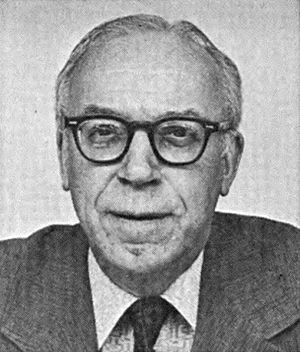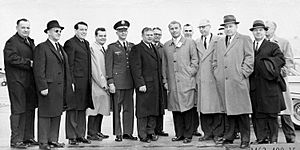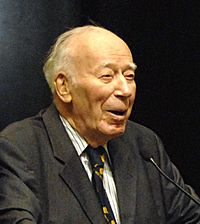Ken Hechler facts for kids
Quick facts for kids
Ken Hechler
|
|
|---|---|
 |
|
| 26th Secretary of State of West Virginia | |
| In office January 14, 1985 – January 15, 2001 |
|
| Governor | Arch A. Moore, Jr. Gaston Caperton Cecil H. Underwood |
| Preceded by | A. James Manchin |
| Succeeded by | Joe Manchin |
| Member of the U.S. House of Representatives from West Virginia's 4th district |
|
| In office January 3, 1959 – January 3, 1977 |
|
| Preceded by | Will E. Neal |
| Succeeded by | Nick Rahall |
| Personal details | |
| Born |
Kenneth William Hechler
September 20, 1914 Roslyn, New York |
| Died | December 10, 2016 (aged 102) Romney, West Virginia |
| Political party | Democratic |
| Spouse |
Carol Denise Kitzmiller
(m. 2013) |
| Residences | Slanesville, West Virginia, U.S. |
| Alma mater | Swarthmore College Columbia University |
| Website | www.kenhechler.us/ |
| Military service | |
| Allegiance | |
| Branch/service | |
| Years of service | 1942–45 |
| Rank | |
| Unit | 9th Armored Division |
| Battles/wars | World War II |
| Awards | |
Kenneth William Hechler (born September 20, 1914 – died December 10, 2016) was an American politician. He was a member of the Democratic Party. Hechler represented West Virginia's 4th congressional district in the U.S. House of Representatives from 1959 to 1977. He also served as West Virginia Secretary of State from 1985 to 2001.
Contents
Biography of Ken Hechler
Early Life and Military Service
Ken Hechler was born in Roslyn, New York, on September 20, 1914. His parents were Charles Henry and Catherine Elizabeth Hechler. He earned a bachelor's degree from Swarthmore College. He also received master's and doctorate degrees in history and government from Columbia University. Before World War II, Hechler taught at Columbia, Princeton University, and Barnard College.
In July 1942, Hechler joined the United States Army during World War II. After training, he became a combat historian. This meant he helped record the events of battles. Hechler documented the liberation of France and the 1944 Normandy invasion. He also covered the Battle of the Bulge and the entry into Nazi Germany.
He was with the 9th Armored Division when they captured the Ludendorff Bridge over the Rhine river. This happened during the Battle of Remagen. Hechler interviewed both American and German soldiers about the battle. He received a Bronze Star and five battle stars for his service. After the war, he returned to Germany to interview more soldiers. In 1957, he published a book called The Bridge at Remagen: The Amazing Story of March 7, 1945. This book was later made into a movie in 1969.
After the war, Hechler interviewed many people before the Nuremberg Trials. These trials were held to prosecute major war criminals.
Starting a Political Career

From 1949 to 1953, Hechler worked as an assistant to President Harry S. Truman at the White House. He also served as Research Director for Adlai Stevenson's presidential campaign in 1956. Later, he became a professor at Marshall University in Huntington, West Virginia.
In 1958, Hechler ran for the United States House of Representatives in West Virginia. He won by a small number of votes. After this first election, he easily won reelection many times.
In Congress, Hechler was known as a liberal Democrat. This means he supported policies that aimed to help people and protect rights. In 1965, he was the only member of Congress to join Martin Luther King Jr. on the Selma to Montgomery marches. Hechler voted for important laws like the Civil Rights Acts of 1960, 1964, and 1968. He also supported the Voting Rights Act of 1965. These laws helped ensure equal rights for all Americans.
Hechler was also a key person in creating the Coal Mine Safety and Health Act of 1969. This law set limits on coal dust in mines and made safety rules stricter. This was very important for the safety of coal miners.
Challenges in Elections
In 1972, Hechler faced a tough election challenge. West Virginia lost a congressional district after the 1970 Census. Hechler's district was combined with another. Even though the new district was mostly new to him, Hechler won the primary election. He then easily won the general election and was unopposed in 1974.
In 1976, Hechler ran for governor but lost. He then tried to run for his old congressional seat as a write-in against Nick Rahall. He lost that election and another one to Rahall in 1978. After these losses, Hechler went back to teaching at Marshall University, the University of Charleston, and West Virginia State University.
Later Political Career
In 1984, Hechler successfully ran for West Virginia Secretary of State. He was re-elected three more times in 1988, 1992, and 1996. As Secretary of State, he was known for fighting against corruption. He helped make a law that required politicians to publicly report loans they received.
In 2000, at 85 years old, Hechler walked 530 miles with Doris "Granny D" Haddock. They walked to support changes in how political campaigns are funded. This effort helped lead to the Bipartisan Campaign Reform Act.
In 2004, Hechler ran for Secretary of State again. He won the Democratic primary but lost the main election to Republican Betty Ireland.
After 2004
After 2004, Hechler became a strong voice against mountaintop removal mining. This is a type of mining that changes mountains. In 2009, at 94 years old, he joined a protest against this mining and was arrested with other protesters.
In 2010, Hechler ran for the U.S. Senate in a special election. His main goal was to bring attention to the problems caused by mountaintop removal mining. He lost the election but continued to speak out.
Hechler was known for his long life and energy. On August 12, 2013, at 98 years old, he married Carol Kitzmiller. On September 20, 2014, he turned 100. He said the secret to living a long time was exercise. Ken Hechler passed away on December 10, 2016, at his home in Romney, West Virginia, at the age of 102.
Works
- Ken Hechler, The Enemy Side of the Hill: The 1945 Background on the Interrogation of German Commanders as Seen Subjectively by Major Kenneth W. Hechler, U.S. Dept. of the Army (1949)
- Ken Hechler, The Bridge at Remagen, Ballantine, First edition (January 1, 1957)
- Ken Hechler, Endless Space Frontier: A History of the House Committee on Science and Astronautics, 1959-1978 (Aas History Series), Univelt (February 1982), ISBN: 978-0-87703-157-4
- Ken Hechler, Working With Truman, Putnam Adult; First Edition (November 19, 1982), ISBN: 978-0-399-12762-5
- Ken Hechler, Working With Truman: A Personal Memoir of the White House Years (Give 'em Hell Harry Series), University of Missouri Press (March 1996), ISBN: 978-0-8262-1067-8
- Ken Hechler, Holding the line the 51st Engineer Combat Battalion and the Battle of the Bulge, December 1944-January 1945 (SuDoc D 103.43/4:4), Office of History, U.S. Army Corps of Engineers (1988)
- Ken Hechler, Holding the Line, University Press of the Pacific (January 30, 2005), ISBN: 978-1-4102-1962-6
- Ken Hechler, River-Horse: The Logbook of a Boat Across America, Penguin Books (1991)
- Ken Hechler, Hero of the Rhine: The Karl Timmermann Story, Pictorial Histories Publishing Company, (January 1, 2004), ISBN: 978-1-57510-110-1
- Ken Hechler, Super Marine!: The Sgt. Orland D. "Buddy" Jones Story, Pictorial Histories Publishing Company (January 2007), ISBN: 978-1-57510-135-4
See also
 In Spanish: Ken Hechler para niños
In Spanish: Ken Hechler para niños


